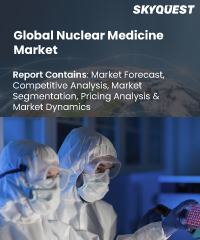
Report ID: SQMIG35I2285

Report ID:
SQMIG35I2285 |
Region:
Global |
Published Date: August, 2024
Pages:
157
|
Tables:
146 |
Figures:
78
Nuclear Medicine Market Drivers
Rising Incidence and Prevalence of Cancer and Cardiovascular Disease (CVD) is a Major Driver of Market Expansion
Technological Advancements in Nuclear Imaging Modalities are one of the Crucial Drivers for the Nuclear Medicine Imaging Market Growth
Nuclear Medicine Market Restraints
Use of Alternative Methods for the Diagnosis of Various Illnesses
Radiopharmaceutical Short Shelf Life
Our industry expert will work with you to provide you with customized data in a short amount of time.
REQUEST FREE CUSTOMIZATIONWant to customize this report? This report can be personalized according to your needs. Our analysts and industry experts will work directly with you to understand your requirements and provide you with customized data in a short amount of time. We offer $1000 worth of FREE customization at the time of purchase.

Report ID: SQMIG35I2285